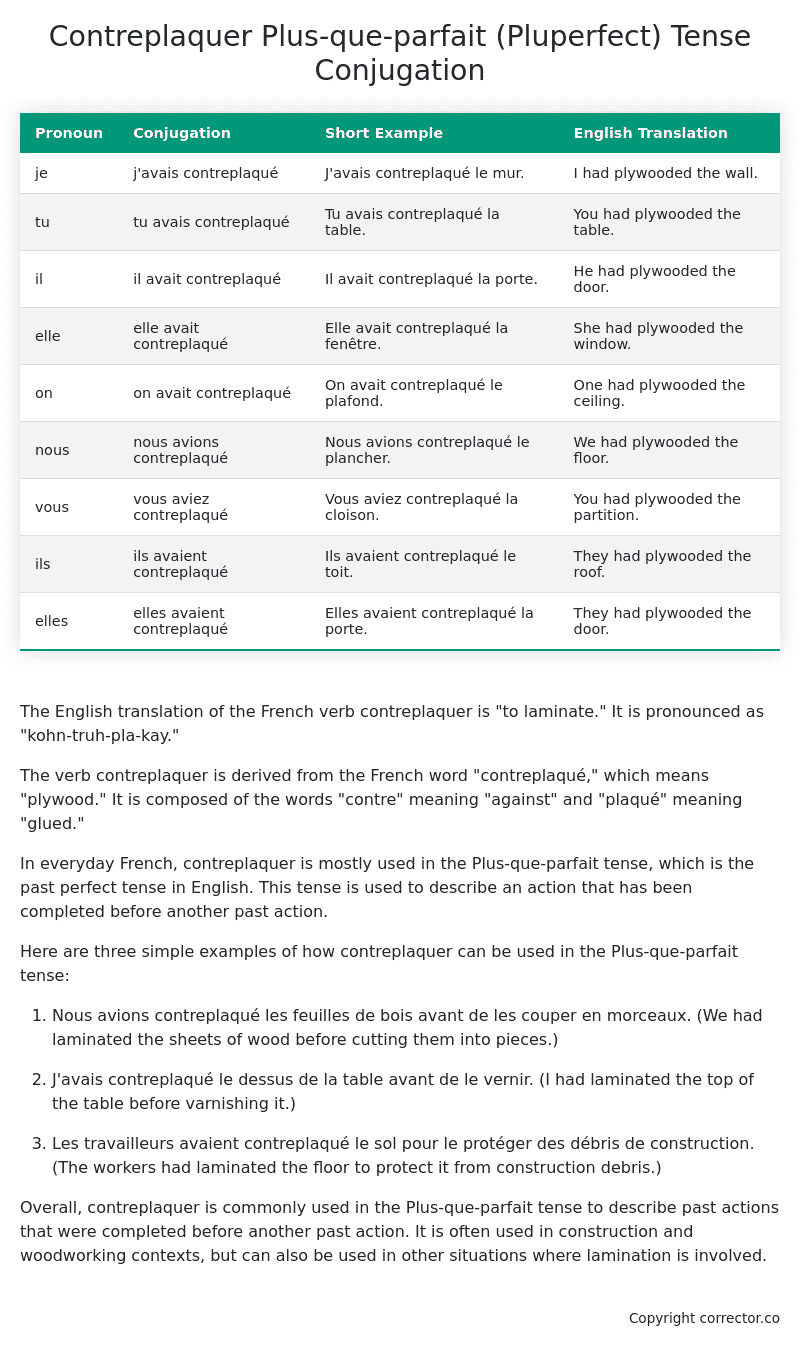Plus-que-parfait (Pluperfect) Tense Conjugation of the French Verb contreplaquer
Introduction to the verb contreplaquer
The English translation of the French verb contreplaquer is “to laminate.” It is pronounced as “kohn-truh-pla-kay.”
The verb contreplaquer is derived from the French word “contreplaqué,” which means “plywood.” It is composed of the words “contre” meaning “against” and “plaqué” meaning “glued.”
In everyday French, contreplaquer is mostly used in the Plus-que-parfait tense, which is the past perfect tense in English. This tense is used to describe an action that has been completed before another past action.
Here are three simple examples of how contreplaquer can be used in the Plus-que-parfait tense:
-
Nous avions contreplaqué les feuilles de bois avant de les couper en morceaux. (We had laminated the sheets of wood before cutting them into pieces.)
-
J’avais contreplaqué le dessus de la table avant de le vernir. (I had laminated the top of the table before varnishing it.)
-
Les travailleurs avaient contreplaqué le sol pour le protéger des débris de construction. (The workers had laminated the floor to protect it from construction debris.)
Overall, contreplaquer is commonly used in the Plus-que-parfait tense to describe past actions that were completed before another past action. It is often used in construction and woodworking contexts, but can also be used in other situations where lamination is involved.
Table of the Plus-que-parfait (Pluperfect) Tense Conjugation of contreplaquer
| Pronoun | Conjugation | Short Example | English Translation |
|---|---|---|---|
| je | j’avais contreplaqué | J’avais contreplaqué le mur. | I had plywooded the wall. |
| tu | tu avais contreplaqué | Tu avais contreplaqué la table. | You had plywooded the table. |
| il | il avait contreplaqué | Il avait contreplaqué la porte. | He had plywooded the door. |
| elle | elle avait contreplaqué | Elle avait contreplaqué la fenêtre. | She had plywooded the window. |
| on | on avait contreplaqué | On avait contreplaqué le plafond. | One had plywooded the ceiling. |
| nous | nous avions contreplaqué | Nous avions contreplaqué le plancher. | We had plywooded the floor. |
| vous | vous aviez contreplaqué | Vous aviez contreplaqué la cloison. | You had plywooded the partition. |
| ils | ils avaient contreplaqué | Ils avaient contreplaqué le toit. | They had plywooded the roof. |
| elles | elles avaient contreplaqué | Elles avaient contreplaqué la porte. | They had plywooded the door. |
Other Conjugations for Contreplaquer.
Le Present (Present Tense) Conjugation of the French Verb contreplaquer
Imparfait (Imperfect) Tense Conjugation of the French Verb contreplaquer
Passé Simple (Simple Past) Tense Conjugation of the French Verb contreplaquer
Passé Composé (Present Perfect) Tense Conjugation of the French Verb contreplaquer
Futur Simple (Simple Future) Tense Conjugation of the French Verb contreplaquer
Futur Proche (Near Future) Tense Conjugation of the French Verb contreplaquer
Plus-que-parfait (Pluperfect) Tense Conjugation of the French Verb contreplaquer (this article)
Passé Antérieur (Past Anterior) Tense Conjugation of the French Verb contreplaquer
Futur Antérieur (Future Anterior) Tense Conjugation of the French Verb contreplaquer
Subjonctif Présent (Subjunctive Present) Tense Conjugation of the French Verb contreplaquer
Subjonctif Passé (Subjunctive Past) Tense Conjugation of the French Verb contreplaquer
Subjonctif Imparfait (Subjunctive Imperfect) Tense Conjugation of the French Verb contreplaquer
Conditionnel Présent (Conditional Present) Tense Conjugation of the French Verb contreplaquer
Conditionnel Passé (Conditional Past) Tense Conjugation of the French Verb contreplaquer
L’impératif Présent (Imperative Present) Tense Conjugation of the French Verb contreplaquer
L’infinitif Présent (Infinitive Present) Tense Conjugation of the French Verb contreplaquer
Struggling with French verbs or the language in general? Why not use our free French Grammar Checker – no registration required!
Get a FREE Download Study Sheet of this Conjugation 🔥
Simply right click the image below, click “save image” and get your free reference for the contreplaquer Plus-que-parfait tense conjugation!

Contreplaquer – About the French Plus-que-parfait (Pluperfect) Tense
Tense Formation
Common everyday usage patterns
Sequencing of past events
Background information
Hypothetical or reported speech
Interactions with other tenses
Summary
I hope you enjoyed this article on the verb contreplaquer. Still in a learning mood? Check out another TOTALLY random French verb conjugation!


